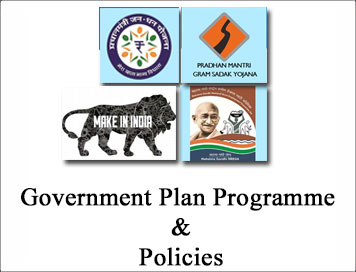(FREE) UPSC Current Affairs 2025 PDF
NEW! The Gist (OCT-2025) | E-BOOKS
Government Plan Programme Policies for UPSC Exam: National Policy on Capital Goods

Government Plan Programme Policies for UPSC Exam
:: National Policy on Capital Goods ::
This policy looks after various aspects of the capital goods from promotion to support staff to overall growth of the sector. Important aims of the national capital goods policy are given below:
- Aims to increase the share of capital goods contribution from present 12% to 20% of total manufacturing activity by 2025.
- clear objective of increasing production of capital goods from ~Rs. 230,000 Cr in 2014-15 to Rs. 750,000 Cr in 2025
- raising direct and indirect employment from the current 8.4 million to ~30 million.
- Become one amongst top 10 capital goods producing nations of the world
- Raise exports to a significant level of at least 40% of total production.
- increasing share of domestic production in India's demand from 60% to 80%, thus making India a net exporter of capital goods.
- The policy also aims to facilitate improvement in technology depth across sub-sectors, increase skill availability, ensure mandatory standards and promote growth and capacity building of MSMEs.
As you can see the national capital goods policy aims to achieve big things by 2025. So this needs supporting structure also in place to get the desired target. In order to achieve the above given objective following policy tools will be used.
-
Creating an Eco-system for globally competitive Capital Goods Sector: Long term strategy for the sector to be defined on the basis of local demand opportunities. Modify public procurement policies to give preferences to local manufacturers within WTO framework and also technology, skills and industrial infrastructure. FTAs / PTAs with partner countries should be re-negotiated further (wherever feasible) with a view to providing equal playing field to local manufacturers.
-
Creation and Expansion of Market for Capital Goods Sector: Close public–private collaboration is required to ensure that the opportunities across the complete production value chain get captured. Provide stable and investor friendly tax regime while actively addressing the current inverted duty structure
-
Promotion of Exports: Introduce market access incentive scheme for capital goods Provide incentives under export promotion scheme such as Merchandise Exports from India Scheme (MEIS) & Service Exports from India Scheme (SEIS). Open a focused line of credit for capital goods exports in partnership with EXIM Bank of India
-
Human Resource Development: Work with Universities & Institutions to promote skills, needed for capital goods sector. Further institutional mechanism to multi-institutions rope in industry for curriculum development and training. Facilitate opening of greater number of training institutes to provide skills required for capital goods industry. Long term, India to be made skill capital of the world.
-
Technology & IPR: To help implementing full fledged scheme on "Enhancement of Competitiveness in the Indian capital goods sector" through enabling policies for technology transfer, up-gradation and innovation. Acquisition of critical technologies will enable more appropriate product portfolios that would facilitate entry into global markets. Incentivize private sector in order to increase R&D expenditure.
-
Introduction of Mandatory Standards: Define national policy to increase present 5% of product range coverage to at least 25% in next 5 years and 50% in 10 years, which are equivalent to international standards. Safety, environment, quality based mandatory standard may be made for all he products in next 5 years. Import of second hand machinery is high in India; mandatory standards should be brought in force to discourage this practice.
-
Focus on SME Development: Promote indigenization with a specific focus on SMEs. Support and promote SME growth by supporting their technology modernizations, skill development, product development and export facilitations. To promote SMEs in the sector, introduce Interest subvention scheme like TUFS which provides concessional rate of interest from 2-4%
-
Support Services: Build up data base of production through suitable reporting system. Work on ITC(HS) codes with a view to increase coverage of description of machinery.
-
Sub-sector specific strategies: THis policy will never be successful if same policy is applied to all the sectors. Some variations related to specific sectors should be there to make policy better for the requirement of the specific sectors. Adjustments like Introduction of minimum standards for equipment, esp on imported second-hand, refurbished machinery in textile industries. Improving technology collaboration with European manufacturers including schemes to promote technology transfer for construction equipments etc. should be done to all the sectors.

